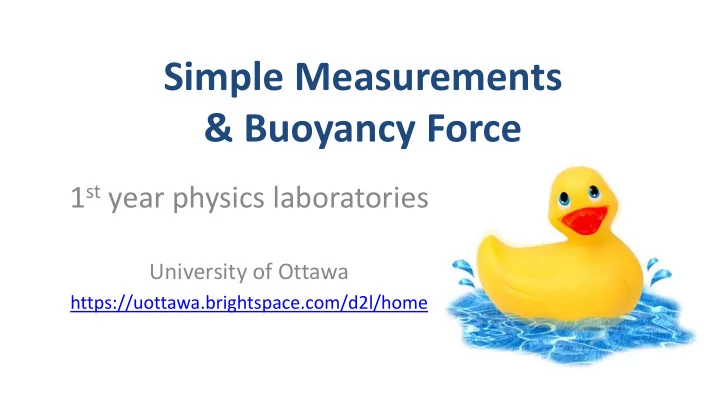

Simple Measurements & Buoyancy Force 1 st year physics laboratories University of Ottawa https://uottawa.brightspace.com/d2l/home
SIMPLE MEASUREMENTS The TA will go over the following tutorials. • Error calculations – There is a test on error calculations on the lab website. – You may complete the test as many times as you want until the deadline. Only your highest mark will be recorded. • How to use the following instruments: – Meter stick – Vernier caliper – Micrometer • Rounding and significant figures.
ERROR CALCULATIONS Propagation of errors: addition and subtraction If the result 𝑆 is obtained from a series of additions and subtractions: 𝑆 = ± 𝐵𝑦 ± 𝐶𝑧 ± ⋯ , where 𝐵 and 𝐶 are constants, then the error on the result 𝑆 is given by 𝐵 2 ∆𝑦 2 + 𝐶 2 ∆𝑧 2 + ⋯ ∆𝑆 = See tutorial – Propagation of errors pg. 1
ERROR CALCULATIONS Propagation of errors: multiplication and division If the result 𝑆 is obtained from a series of products: 𝑆 = 𝑦 𝐵 𝑧 𝐶 ⋯ , where 𝐵 and 𝐶 are constants, then the error on the result 𝑆 is given by ∆𝑆 = 𝑆 𝐵 2 ∆𝑦 2 𝑦 2 + 𝐶 2 ∆𝑧 2 𝑧 2 + ⋯ See tutorial – Propagation of errors pg. 2
REPEATED MEASUREMENTS When dealing with multiple measurements, we use the statistical quantities: mean (or average), standard deviation , and standard error ( SE ) to interpret our data. - The mean (or average) is an estimate of the “true” value of the measurement. - The standard deviation is a measurement of the “spread” in your data. If you took one more measurement, you can be ~70% sure that this value will be one standard deviation away from your mean. - The standard error is an estimate of the uncertainty in the mean value. If you repeated your experiment, you can be ~70% sure that the new mean will be one standard error away from your original mean. See tutorial – Repeated Measurements
MEASURING INSTRUMENTS See tutorial - Measuring techniques Vernier caliper: for lengths between 1 cm and 10 cm
MEASURING INSTRUMENTS 3 Absolute uncertainties: • Meter stick: ± 0.5 mm (per reading) • Vernier caliper: ± 0.05 mm • Balance: ± 0.1 g • Stopwatch: ± 0.2 – 0.5 sec
SIGNIFICANT FIGURES AND ROUNDING See tutorial – Experimental errors pg. 6
LAB 1: OBJECTIVES • Part 1: Length measurement – Measure dimensions of an object to find its volume and calculate its density – Determine material type from a density table – Use uncertainty and perform error calculations • Part 2: Time measurement – Calculate the period of oscillation of a pendulum – Determine statistical quantities such as average, standard deviation, and standard error • Part 3: Investigate Archimedes’ principle regarding buoyant forces – Determine the value of the density of a liquid using a force sensor to measure the buoyancy of an object gradually being submerged in water. – Generate a graph of the buoyancy force vs. volume of displaced water and use a linear regression tool to determine the density of water.
Part 1 - Length measurement The instruments and the cylinder: Solid cylinder Vernier caliper Meter stick
Part 2 - Time measurement The pendulum: 100 g Stopwatch
BUOYANCY FORCE • The buoyant force, F b , exerted on an object partially or fully submerged in a fluid is equal to the weight of the displaced fluid: F b = ρ Vg • Use a force sensor to measure F b experienced by an object gradually immersed in water. • Make a plot of F b vs. V , use a linear regression to find ρ .
Part 3 – Buoyancy force setup The setup: A closer look: Force sensor Graduated Lab jack cylinder and immersed masses
Buoyancy force setup (cont.) A 500 g mass will be suspended in water over an electronic balance. Your TA will set up this part. The balance will first be zeroed with only the beaker and water. Then the mass will be submerged in the water and you will record the reading on the balance.
CLEAN UP • Turn off the computer. Don’t forget to pick up your USB key if you used one! • Throw away the water in your graduated cylinder in the sink in front of the classroom. Let your cylinder dry near the sink. Use brown paper to dry the suspended masses (they will rust!) . • Your kind TA will clean up the setup at the front of the class for the 500 g mass submerged in the beaker on the balance. • Recycle scrap paper and throw away any garbage. Leave your station as clean as you can. • Push back the monitor, keyboard and mouse. Also please push your chairs back under the table.
DUE DATE REMINDER: Exp. 0! Do the 4 tests in Exp. 0 folder before The report is due in 1 week. the deadline! The dropbox is located in the central corridor of STM 3 rd floor south tower. PRE-LAB Please make sure you put it in the correct dropbox! Don’t forget to do your pre -lab for Exp. 2! Don’t wait until the last minute, there will be no extension or make-up for students experiencing technical problems a few minutes before the deadline!!
Recommend
More recommend